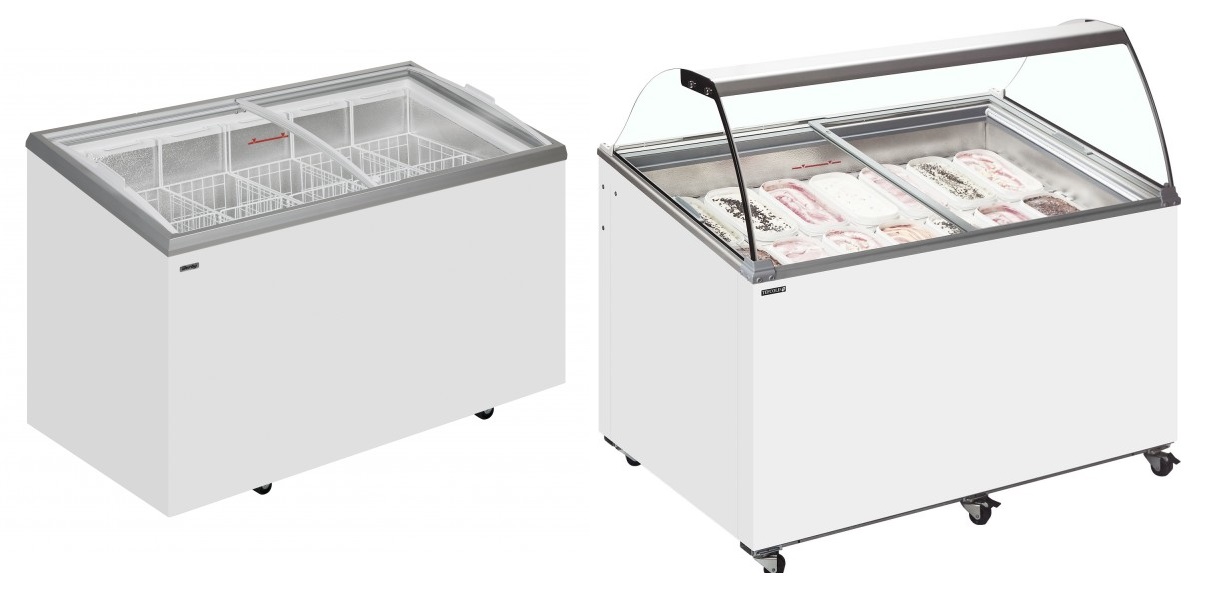
Ice cream sales can be big business and so it’s vital that, if you want to crack the market, you understand exactly what commercial ice cream refrigeration consists of and how to go about choosing equipment best suited to your requirements.
This definitive ice cream refrigeration buying guide gives the full scoop, detailing everything you need to know before making a purchase.
Table of Contents
What is Ice Cream Refrigeration?
Why Buy Commercial Ice Cream Refrigeration?
Types of Ice Cream Refrigeration
Design & Purpose
Ice Cream Storage & Display Temperatures
Size and Capacity
Positioning and Airflow
Cooling and Defrost Types
Power Requirements
Specifications and Features
Commercial Ice Cream Freezer Efficiency
Brand, Manufacturing Quality and Price
Choose your Warranty
Cleaning, Servicing and Maintenance
How Often Should You Defrost Your Freezer?
Get Advice
What is Ice Cream Refrigeration?
Ice cream refrigeration is the general umbrella term used to cover any commercial freezer that is suitable for holding ice cream.
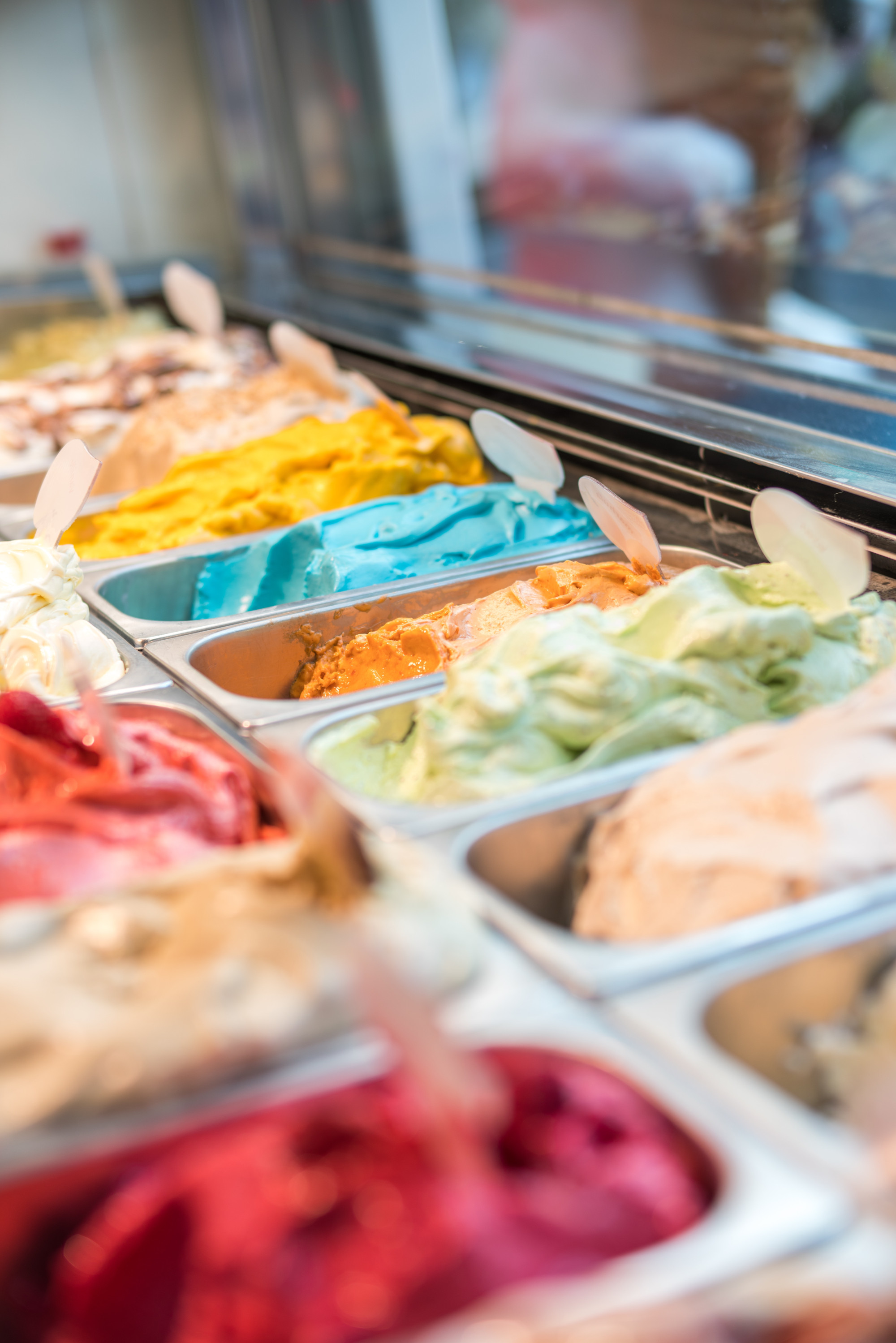
Equipment in this category is often similar to other commercial freezers however will operate with the necessary precision to guarantee that your ice cream is never compromised in terms of quality, consistency or taste.
Ice cream freezers can be divided into two main categories: Storage and Display. Each category will offer varying designs, functions and temperature ranges. The common feature between both categories is the generation of even and consistent conditions conducive to high quality ice cream.
Not only suitable for ice cream, we have many products that can also be used to store or display gelato, sorbet, frozen yoghurt and granita (similar to sorbet but with a crunchier texture, often served as a slush type drink).
Why Buy Commercial Ice Cream Refrigeration?
Ice cream sales can be a great way to boost profits all year round but especially during the summer months. To make sure that the frozen treats you offer are on point it’s vital to invest in equipment made specifically for purpose.
As the title suggests commercial ice cream freezers are purposely designed to perform in tough commercial settings. This means better, more durable build quality than domestic counterparts, increased efficiency, improved consistency and more features. When ice cream isn’t stored or displayed in the right environment it can have an adverse effect on texture, consistency and flavor and therefore your end profit.
By investing in commercial equipment, you can guarantee high quality results and the best shelf life from your frozen treats. As there’s plenty of choice available when it comes to styles and designs, finding the right piece of equipment is simple.

Types of Ice Cream Refrigeration
Storage
- Ice cream storage freezers are capable of achieving lower temperatures.
- Will typically have either a solid lid or solid door.
- Available as upright cabinets or in a mobile chest freezer design.
Display
- Ice cream display freezers operate at slightly higher temperatures although still sub-zero.
- Will typically have either a glass lid or glass canopy through which ice cream is visible.
- Available in a chest freezer design, as a compact countertop unit or as an ice cream serveover, often referred to as a soft scoop display freezer.
Design & Purpose
Once ice cream freezers have been split into two main categories – Storage and Display, they can then be filtered down further depending on the intended purpose and the preferred design of the unit.
|
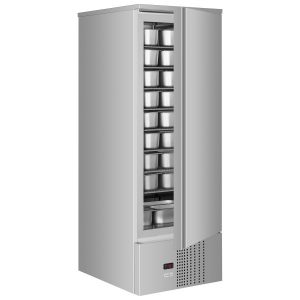
|
Design: | Upright cabinet |
| Purpose: | Storage & Tempering | |
| Info: | May be suitable for both storage and tempering purposes giving a multi-functional approach. | |
| Can be found in: | Ice Cream Storage Freezers | |
|
|
||
|
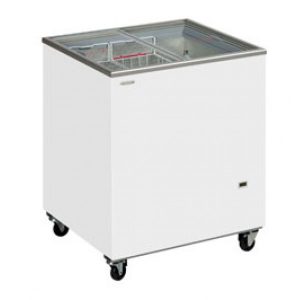
|
Design: | Chest freezer |
| Purpose: | Storage or Display | |
| Info: | Robust design with good insulation properties. Available as solid lid freezers or glass lid freezers, depending on whether intended for storage or display use. | |
| Can be found in: | Mobile Ice Cream Freezers Ice Cream Display Freezers | |
|
|
||
To read more about commercial chest freezers take a look at our handy buying guide.
|
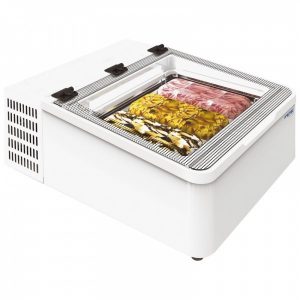
|
Design: | Countertop |
| Purpose: | Display | |
| Info: | Compact in size to facilitate ice cream sales in any location. | |
| Can be found in: | Countertop Ice Cream Displays | |
|
|
||
|
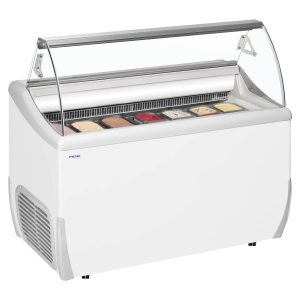
|
Design: | Serveover counter |
| Purpose: | Display & Serve | |
| Info: | Will have either a flat or curved glass canopy. Will hold slightly higher temperatures to make sure ice cream is soft enough to scoop and serve. | |
| Can be found in: | Soft Scoop Ice Cream Displays | |
|
|
||
Ice Cream Storage & Display Temperatures
All frozen treats whether ice cream, gelato, sorbet, granita or frozen yoghurt need consistent, even temperatures whether during storage or display to prevent excessive formation of ice crystals. Large ice crystals as a result of repeatedly fluctuating temperatures may produce sub-standard quality, ruining the overall experience of indulging in this cold treat. The exception to this rule being granita which relies on large ice crystals to hold the frozen juice from which it is made.
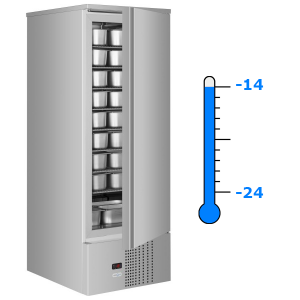
The temperature range of each piece of equipment will be dependent on its intended use.
Ice Cream Storage freezers will generally range between -14°C and -24°C however all contents should ideally be stored at a temperature lower than -18°C.
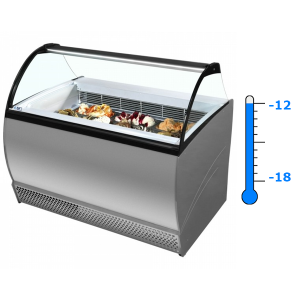
Ice Cream Display freezers will generally operate with a range between -12°C and -18°C. This creates the perfect consistency to scoop and serve ice cream without it becoming too soft.

If wanting to store or display gelato, not every ice cream freezer will be suitable.
- Gelato requires slightly higher temperatures and conditions in order to achieve the softer consistency. Read more about the differences between ice cream and gelato and appropriate types of refrigeration in our knowledge base.
- When storing and displaying sorbets, you will need equipment and temperatures similar to those required for gelato.
- For frozen yoghurts and granita, look for equipment and temperatures similar to those required for ice cream.

How long can ice cream be stored?
*These time frames are aimed to be an approximate guideline only, when products are stored unopened at optimum temperatures.
**Always check best before and use by dates for guidance.
| Product Type | Approximate Storage Lifespan |
| Ice cream | up to 2-3 months |
| Gelato | up to 1-11/2 months |
| Frozen yoghurt | up to 2-3 months |
| Sorbet | up to 2-4 months |
| Granita | up to ½ month |
Obviously once opened, the shelf life of products will be reduced. It should also be noted that continuously moving ice creams and other frozen treats (with the exception of granita) from storage to display and vice versa will lead to larger ice crystals being formed and a reduction in quality.
The Truth about Freezer Burn
The longer ice cream is stored in a freezer the greater the risk of freezer burn. Freezer burn occurs when moisture rises to the surface of the ice cream and refreezes forming a layer of ice. This external layer of ice has a massive negative effect on the quality, consistency and flavor of the product. Once freezer burn has set in, it cannot be remedied.
Size and Capacity
You’ve made a decision about the type of ice cream freezer you need and the design and purpose that best suits your requirements, so now it’s time to start narrowing down the possibilities even further.
With small countertop models, compact upright cabinets, a range of chest freezer dimensions and a number of displays available there’s plenty to choose from and all in an array of shapes, sizes and capacities.
The size of your ice cream freezer will ultimately reflect the capacity: larger dimensions will generally mean there’s a greater space to hold stock. The size and capacity you need will depend on a number of factors including the space you have available to house the equipment, the scale of ice cream sales you’re aiming for and the number of flavours you want to offer.
Step 1 – Measure
The first step should always be to accurately measure the intended area where equipment is to be positioned. This will give you vital information as to the maximum external dimensions that your freezer can possibly be. Once you have this information you can begin to narrow down your search.


Step 2 – Measure again
This may seem like a waste of time, after all the space won’t have grown overnight, however it’s always best to be absolutely certain. At this point also pay attention to access points into your premises i.e. any doorways, corridors or tight corners - basically will the equipment actually fit into the building?
Once you have completed a purchase and the order has been processed and dispatched from the manufacturer, it can become a costly affair to cancel or return equipment.
Step 3 – Capacity
The dimensions are sorted, now it’s time to whittle down the selection based on capacity. This figure will vary greatly between different types and styles of ice cream freezer.
Some units will stipulate capacity in litres. This may be shown as a gross or net figure. In these instances, always pay attention to the net volume as this is the number that indicates the actual usable capacity.
You may find that capacity may also be denoted using a maximum number of pans or baskets. When addressing capacity in these terms always consider the number of flavours you wish to sell and the quantity of stock you will need to meet demand.
Step 4 - Storage type
Storage type will typically depend on the design and purpose of the ice cream freezer in question.

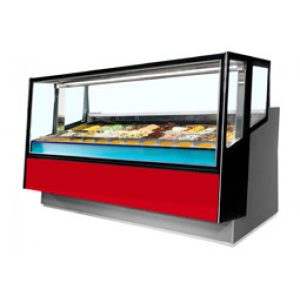
need to be purchased at an extra cost.
Chest freezer models of ice cream refrigeration will typically hold between 1 and 7 baskets. You may like the Elcold Focus Chest Freezer holding up to a maximum of seven baskets.
Serve over styles of ice cream display will typically hold between 4 and 24 Napoli pans. Take a look at the Igloo Aruba which is designed to hold up to 28 Napoli pans.
Upright ice cream storage cabinets often have shelves that accommodate many Napoli pans. Check out the ISA Labor70 RS/RV Ice Cream Storage Freezer with 5 adjustable shelves and the capacity to hold up to 65 Napoli pans.
References to pans are generally based on 5 litre tubs however it’s always advised to check the size of the pans that your ice cream is supplied in to make sure they will fit. Some suppliers may deliver their ice cream in 4 litre tubs as standard.
Positioning and Airflow
Where you position your ice cream freezer will ultimately depend on it’s intended purpose.
Storage and tempering freezers are more functional with solid lids or doors, serving only to hold or condition ice cream. They are therefore better placed in storage areas behind the scenes.
Ice cream display freezers, including glass lid chest freezers and soft scoop ice cream display freezers are not only functional, holding ice creams at optimum temperatures but also serve as an effective merchandising tool, showcasing the delicious treats available and actively enticing customers to buy. In order for display freezers to work their magic it’s essential that they be positioned in areas visible by the public.
Always Consider Airflow
As with all commercial refrigeration equipment, ample airflow is required in order for the unit to perform effectively and operate efficiently. The general rule is to allow at least an approximate 5cm air gap around the exterior of the unit which is considered sufficient to allow the refrigeration to ‘breathe’.
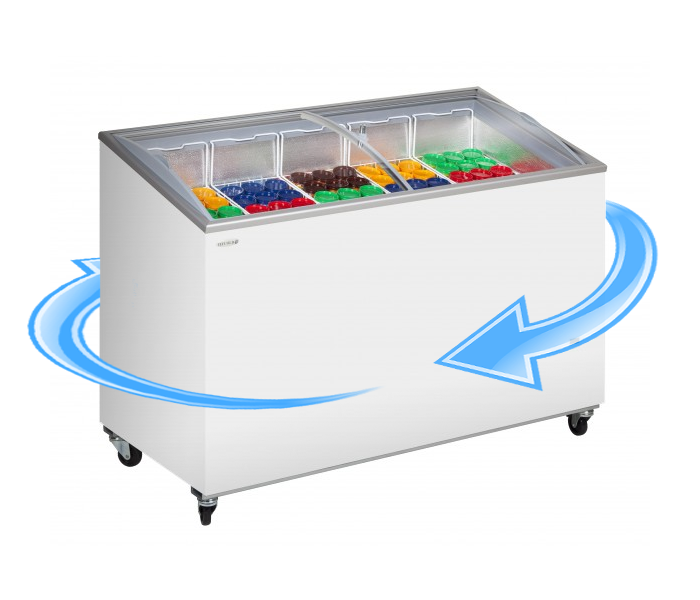
Adequate airflow isn’t only applicable to the exterior of the ice cream freezer. It is essential that when stocking and filling the unit, whether it’s for storage or display, the interior also has unrestricted air circulation. This allows temperatures to be evenly and consistently maintained in order to preserve the quality of your ice creams.

Cooling and Defrost Types
As with other forms of commercial refrigeration, there are a number of cooling and defrost systems available. Understanding the basics, both how the refrigeration cycle works in general and the different variations or methods of cooling and defrost available, can help you make the right decision when it comes to your ice cream displays and storage freezers.
Cooling
Ventilated

Ventilated cooling operates in a similar way to fan assisted, a term often seen in other refrigeration categories however ventilated is the term most frequently used in conjunction with ice cream freezers. This system works by cold air being actively circulated around the internal cavity by fans. As cold air is forced around the freezer it is possible to position Napoli pans higher in the unit without any negative effect on the consistency of temperatures and conditions. This ensures that ice creams are clearly visible by customers. Ventilated systems can be used for storage and display of dairy ice cream and gelato.
Static
This system relies on the natural circulation of cold air within the freezer. This can result in uneven air distribution, a decrease in consistency and a risk of ‘hot spots’ or pockets of warm air. As cold air naturally sinks and there are no fans to force the air upwards, Napoli pans will often need to sit lower in the freezer well to benefit from the cold temperatures. This can result in pans being less visible to customers, in the case of display freezers. Static cooling should only be used for dairy ice cream.
Defrost
Automatic/Electric
This system relies on electric elements to heat the evaporator and thaw any build-up of ice. It will work on a predefined timed cycle which will typically be factory set.
Water from the thawed ice will be collected in a tray (sometimes called a condensate tray) close to the motor. Here it is heated as a result of the refrigeration process and will evaporate.
While this is a less hands-on defrost method, it will use more power resulting in higher operating costs.

Hot Gas
Rather than electric elements as in the case of an automatic defrost, hot gas defrost systems use heated vapour from the compressor to warm the evaporator coil and thaw ice.
As with automatic defrost systems, water produced by the thawed ice is collected and will evaporate thanks to the heat created through the refrigeration process.
This can be a great energy saving method of defrost as up to 70% of the heat generated is diverted back to the coil during defrost, leaving only 30% to be dispersed.
Manual
As the name suggests, manual defrost is hands-on and time consuming. When there is a build-up of ice, the freezer should be emptied and switched off. All ice must be removed by hand however stay clear of sharp tools as they could potentially damage the interior surfaces of the freezer.
This method is the most energy efficient however it’s vital to weigh this advantage up against the number of man hours involved and the inconvenience of having to relocate stock during the defrosting process.
Ultimately the choice of cooling and defrost method will be determined by personal preference, what you want from the equipment and the amount of time you are able to allocate to maintenance.
Power Requirements
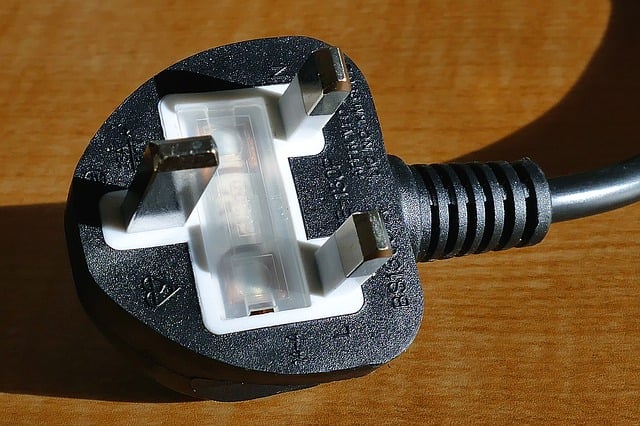
Basically, the more kilowatts that a freezer specifies, the more power it uses. The vital power aspect to consider is the amps that the equipment requires. Many smaller models will run off a 13A supply which is a standard 3 pin plug. This is an easy ‘plug and play’ option meaning you can literally plug in the equipment and use it without any fuss.
Larger equipment will need more power to operate effectively. These units may require 20A or 32A hardwired connections, which can be either single or 3 phase. While all premises are equipped to deal with 13A supplies, not all buildings will be configured to handle larger amperes.
Before making an order always check your premises to see what power it is set up for. If you buy a freezer or display with a 3 phase connection yet your building isn’t configured to support this, it can be quite pricey to convert. Likewise, if you purchase equipment with the wrong power supply, you will be charged a restocking fee should you wish to return your order.
Specifications and Features
There are many specifications and features to look out for when searching for your perfect ice cream freezer. All features will depend on the type, design and purpose of the equipment however here are a few areas you may want to consider.
- Storage and display freezers in a chest freezer style will have either sliding or hinged lids. Both offer good access to contents and are similarly efficient therefore your primary concern should be any potential access issues that a hinged lid could create due to additional height being required and of course there’s a certain element of personal preference involved.
Soft scoop displays, while adopting a similar style to that of a serveover, may also feature sliding lids.
With regards to sliding lids always consider practicality during busy periods when more than one person is serving. Each may need to access the freezer simultaneously, a struggle when each individual wants to get into the opposite end and you can only open one sliding lid at a time. - Every ice cream freezer relies on accurate and consistent temperatures. A precision thermostat is vital with regards to preserving the quality and flavour of the contents. Always choose a temperature range that best suits your intended purpose. For more information on freezer temperatures jump to Ice Cream Storage and Display Temperatures.
- There are different cooling and defrost types to choose from. Investigate each and determine which works best for you. See Cooling and Defrost Types.
- Do you need locks? This can be a great way to increase security for your stock.
- Although typically included as standard, always look for a defrost drain. This makes any defrosting process, whether manual, hot gas or automatic/electric as clean and mess-free as possible.
- When looking for a soft scoop freezer display consider whether you need understorage and how it is accessed where available. Under storage is perfect for holding additional stock and supplies. Access may be from above by removing pans already situated or via rear doors.
- Do you need a serving shelf on your ice cream display? While some models with have a small shelf similar to that of a serveover counter, others won’t, so always check design specifications.
- All ice cream display refrigeration will have some sort of cover to protect contents whilst they’re on display. This may be in the form of glass lids, glass canopy or hygiene/sneeze guard. Screens and canopies are available with either flat or curved glass meaning there’s a perfect design to suit every business style.
- Large units can be heavy, cumbersome and difficult to manoeuvre (as with chest freezers and serveovers). Consider whether a unit has castors as standard as this can help with mobility and positioning of equipment.
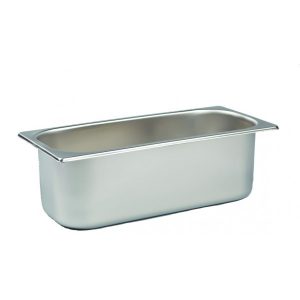
Accessories
You’ve narrowed down your potential equipment but don’t forget about your ice cream accessories. Most common are Napoli pans which are very similar to certain sized gastronorm pans that can be found in commercial kitchens. Ice cream may be supplied from source in plastic tubs however some businesses choose to insert these plastic tubs into stainless steel Napoli pans to enhance aesthetics. Additional baskets for storage freezers may also be required.
When getting ready for ice cream service you may also need cone holders so that you don’t have to fumble with multiple cones, dippers and scoops to create traditional balls or spades with flat blades, perfect for when pans are nearly empty (also handy for mixing and packing).
By remembering the basic accessories and tools of the trade, you can make sure your ice cream storage and display goes without a hitch.
Commercial Ice Cream Freezer Efficiency
All commercial refrigeration is designed to operate as efficiently as possible. Ice cream freezers are no exception, however the level of efficiency may vary slightly depending on the design of the unit.
Chest freezer styles offer the high levels of efficiency typically associated with this type of equipment. The top access point means that cold air circulates within the freezer cavity and is effectively contained by the lid. The majority of cold air remains within the freezer when the lid is opened.
Soft scoop displays which feature sliding lids also offer good levels of efficiency as they’re effectively a chest freezer with an additional external glass canopy or hygiene guard.
Ice cream serving counters without lids are more open and therefore slightly less efficient in comparison with other designs. Essentially a basic chest freezer frame (minus the lid), the cold air will still circulate within the freezer cavity however will have a route to escape.
Upright cabinets are not as efficient as chest designs as when the door is opened, air from the full height of the freezer can escape. This means that refrigeration needs to work harder to pull storage conditions back down to appropriate temperatures once the door is shut.

Top 5 Tips for Efficiency
- Make sure lids or doors are securely closed to prevent escape of cold air.
- Keep refrigeration components clean and unobstructed, allowing them to perform to their full capabilities.
- Ensure there’s adequate airflow around the exterior and interior of the equipment.
- Check seals regularly to make sure they are in good condition and tight fitting to prevent loss of cold air.
- Correctly service and maintain equipment. This can take the strain off components and potentially increase the longevity of equipment.

Brand, Manufacturing Quality and Price
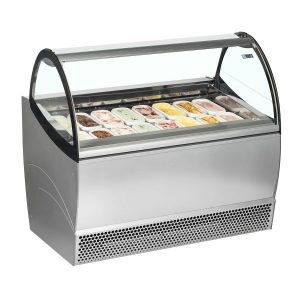
Brand, manufacturing quality and price are generally closely linked with one area typically reflective of the other two however in the case of ice cream refrigeration the lines blur slightly. Manufacturer’s will typically design and produce a range of models to suit all budgets. The build quality is the same however the price will reflect the size and the standard features that are included.
An excellent example of this is with ISA ice cream displays. They supply the Fiji range for businesses shopping on a budget, the Isabella range as the perfect middle ground and the Millennium range where price isn’t an issue.
With ice cream storage and display freezers available from a wide array of industry renowned brands such as Tefcold, Mercatus, Vestfrost, Elcold, Artikcold, Framec and Igloo there’s plenty to suit every style requirement, purpose and budget.
Spread the Cost with Commercial Leasing
Investing in the best can cost a pretty penny but even businesses with a strict budget can benefit from the perfect equipment. Commercial leasing is available on all orders in excess of £1000 exc. VAT, freeing up ready cash for other areas and allowing you to spread the total cost into manageable monthly repayments.
Choose your Warranty
All commercial refrigeration offers some form of warranty whether that be parts only or full parts and labour cover. In the case of ice cream refrigeration, a typical warranty term generally covers a 12 to 24 month period.

We Recommend:

We always advise to opt for the longest warranty period available with full coverage. This gives peace of mind that, should any issues occur (that are not due to user error), the cost of replacement parts and engineer call-out and labour charges will be covered.
For more information regarding levels of cover, take a look at our Commercial Warranties page.
Cleaning, Servicing and Maintenance
Cleaning, servicing and maintenance are key procedures with any commercial refrigeration units, not only to observe hygiene and food safety but also optimise performance, boost efficiency and improve the expected lifetime of the unit.
Employing a qualified refrigeration engineer to service ice cream equipment every 6 – 12 months is a great way to make sure you get the most out of your investment.
In-house cleaning processes are just as important. Government guidelines are available as to correct food safety practises.
Tips for Cleaning Chest Freezer and Cabinet Styles
- Defrost as required and wipe surfaces down with a cloth and mild soapy water.
- During cleaning always check for and remove any dust or debris from the condenser, fans or vents by either by wiping or vacuuming.
- Always check any freezer door or lid sealing strips for damage. An incomplete seal may result in the escape of cold air leading to a reduction in efficiency and performance. Some models are designed with easily replaceable seals meaning that replacement can be carried out by staff without the need for a professional.
Tips for Cleaning Soft Scoop Displays
- We recommend that all tubs/pans in soft scoop serving freezers be removed from the display at the end of the day. They should be covered/sealed and put into appropriate freezer storage overnight.
- Defrost when necessary.
- Interior and exterior surfaces of display equipment should be wiped down and cleaned with a cloth and mild soapy water ready for the next day.
- Remove any dust or debris from the condenser, vents or fans either by wiping or vacuuming.
- Clean and sterilise all accessories, tools and utensils.

How Often Should You Defrost Your Freezer?
The regularity with which you defrost your ice cream freezer will depend on the type of defrost function that your equipment operates, how you use your freezer and where the freezer is positioned.

Automatic/electric and hot gas defrost functions will run on a regular cycle according to a timer which is typically a predefined setting determined by the factory. This operates without manual intervention.
The frequency and length of time the door or lid is left open and the humidity and ambient temperature in the surrounding environment may affect the regularity of defrosting. At the point of manufacture, the factory will take all of these factors into consideration on average and use this information to determine how often cycles run. This may be once a day or at multiple points throughout the day.
Manual defrosts should be carried out as soon as any ice builds-up to approximately a quarter of an inch thick.
Neglecting to defrost your freezer as soon as ice build-up is noticeable can result in a reduction in the quality of contents, an increase in energy consumption and a greater risk of breakdowns.
Get Advice
Choosing the right equipment can make a big difference to the quality of your ice cream and therefore your potential sales. If you’re unsure which piece of ice cream refrigeration would be best suited to your business always ask for advice. To make sure you make the right decision first time, our team of experts are on hand so give us a call for free impartial advice.

Leave a Comment
Your email address will not be published. Required fields are marked *